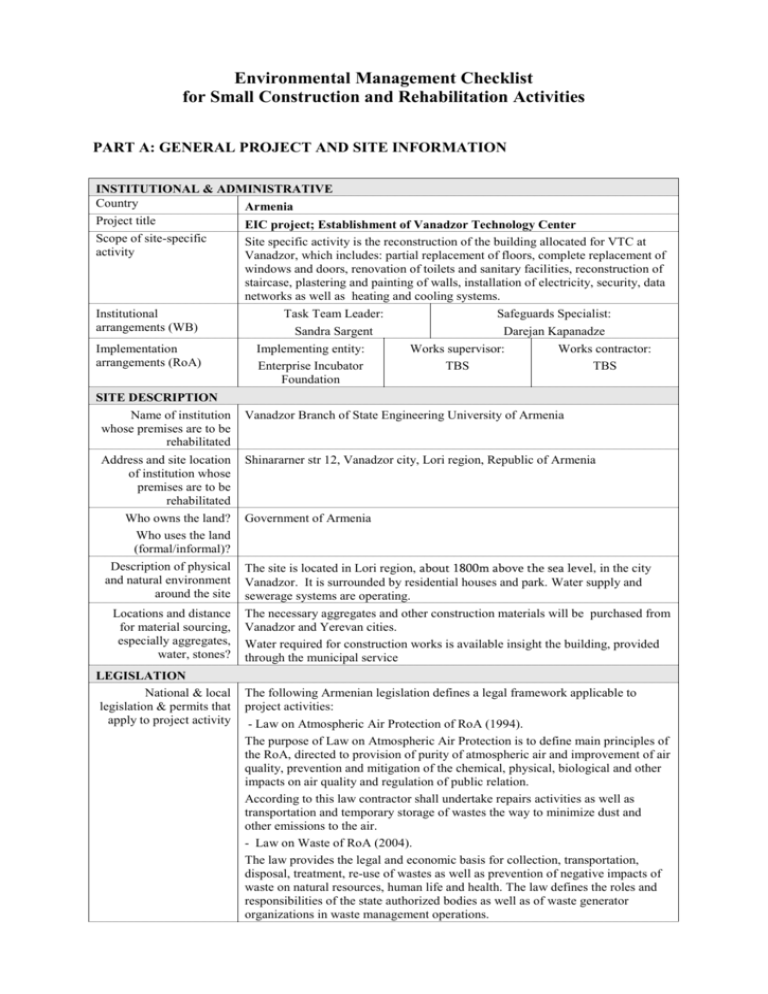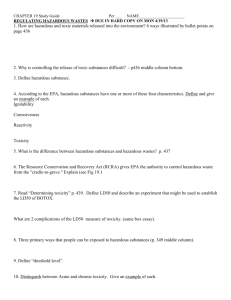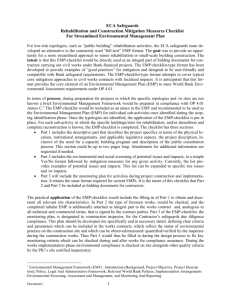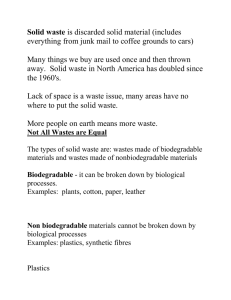Here - Enterprise Incubator Foundation
advertisement

Environmental Management Checklist for Small Construction and Rehabilitation Activities PART A: GENERAL PROJECT AND SITE INFORMATION INSTITUTIONAL & ADMINISTRATIVE Country Armenia Project title Scope of site-specific activity Institutional arrangements (WB) Implementation arrangements (RoA) SITE DESCRIPTION Name of institution whose premises are to be rehabilitated Address and site location of institution whose premises are to be rehabilitated Who owns the land? Who uses the land (formal/informal)? Description of physical and natural environment around the site Locations and distance for material sourcing, especially aggregates, water, stones? LEGISLATION National & local legislation & permits that apply to project activity EIC project; Establishment of Vanadzor Technology Center Site specific activity is the reconstruction of the building allocated for VTC at Vanadzor, which includes: partial replacement of floors, complete replacement of windows and doors, renovation of toilets and sanitary facilities, reconstruction of staircase, plastering and painting of walls, installation of electricity, security, data networks as well as heating and cooling systems. Task Team Leader: Sandra Sargent Implementing entity: Enterprise Incubator Foundation Safeguards Specialist: Darejan Kapanadze Works supervisor: TBS Works contractor: TBS Vanadzor Branch of State Engineering University of Armenia Shinararner str 12, Vanadzor city, Lori region, Republic of Armenia Government of Armenia The site is located in Lori region, about 1800m above the sea level, in the city Vanadzor. It is surrounded by residential houses and park. Water supply and sewerage systems are operating. The necessary aggregates and other construction materials will be purchased from Vanadzor and Yerevan cities. Water required for construction works is available insight the building, provided through the municipal service The following Armenian legislation defines a legal framework applicable to project activities: - Law on Atmospheric Air Protection of RoA (1994). The purpose of Law on Atmospheric Air Protection is to define main principles of the RoA, directed to provision of purity of atmospheric air and improvement of air quality, prevention and mitigation of the chemical, physical, biological and other impacts on air quality and regulation of public relation. According to this law contractor shall undertake repairs activities as well as transportation and temporary storage of wastes the way to minimize dust and other emissions to the air. - Law on Waste of RoA (2004). The law provides the legal and economic basis for collection, transportation, disposal, treatment, re-use of wastes as well as prevention of negative impacts of waste on natural resources, human life and health. The law defines the roles and responsibilities of the state authorized bodies as well as of waste generator organizations in waste management operations. According to this law, the waste generated during renovation of the building should be recycled as appropriate, or disposed of in designated locations. - Law on Environmental Impact Assessment of RoA (1995). The law defines types of activities which are subject to environmental impact assessment and ecological expertize. According to this law, works for the rehabilitation of premises for the Institute are not subject to the ecological expertize. - Law on Urban Development of RoA (1998). The law defines types of activities which are subject to construction permitting. According to this law, works planned at Institute do not require obtaining of the construction permit. PUBLIC CONSULTATION When / where the public The public consultations will take place in Vanadzor, as well as info will be consultation process will placed at EIF and RA Min. Economy websites. take /took place ATTACHMENTS Attachment 1: Site plan / photo PART B: SAFEGUARDS INFORMATION ENVIRONMENTAL /SOCIAL SCREENING Will the site activity include/involve any of the following? 1 Activity/Issue Status Triggered Actions A. Building rehabilitation [x] Yes [ ] No See Section A below B. New construction (TBD) [ ] Yes [ x] No See Section A below C. Individual wastewater treatment system [ ] Yes [x ] No See Section B below D. Historic building(s) and districts [ ] Yes [x ] No See Section C below E. Acquisition of land1 [ ] Yes [x ] No See Section D below [ ] Yes [ x] No See Section E below G. Impacts on forests and/or protected areas (impact assessment will be carried out in parallel with site engineering design works) [] Yes [ x] No See Section F below H. Handling / management of medical waste [ ] Yes [ x] No See Section G below I. [ x] Yes [] No See Section H below F. Hazardous or toxic materials 2 Traffic and Pedestrian Safety (impact assessment will be carried out in parallel with site engineering design works) Land acquisitions includes displacement of people, change of livelihood encroachment on private property this is to land that is purchased/transferred and affects people who are living and/or squatters and/or operate a business (kiosks) on land that is being acquired. 2 Toxic / hazardous material includes but is not limited to asbestos, toxic paints, noxious solvents, removal of lead paint, etc. PART C: MITIGATION MEASURES ACTIVITY (a) 0. General Conditions A. General Rehabilitation and /or Construction Activities PARAMETER (b) Notification and Worker Safety Air Quality Noise Water Quality Waste management B. Impacts on surface drainage system Water Quality MITIGATION MEASURES CHECKLIST (c) The local construction and environment inspectorates and communities have been notified of upcoming activities (d) The public has been notified of the works through appropriate notification in the media and/or at publicly accessible sites (including the site of the works) (e) All legally required permits have been acquired for construction and/or rehabilitation (f) The Contractor formally agrees that all work will be carried out in a safe and disciplined manner designed to minimize impacts on neighboring residents and environment. (g) Workers’ PPE will comply with international good practice (always hardhats, as needed masks and safety glasses, harnesses and safety boots) (h) Appropriate signposting of the sites will inform workers of key rules and regulations to follow. (a) During excavation works dust control measures shall be employed, e.g. by spraying and moistening the ground (b) Demolition debris, excavated soil (if required) shall be kept in controlled area and sprayed with water mist to reduce debris dust (c) During pneumatic drilling or breaking of pavement and foundations dust shall be suppressed by ongoing water spraying and/or installing dust screen enclosures at site (d) The surrounding environment (school yards) shall be kept free of soil and debris to minimize dust (e) There will be no open burning of construction / waste material at the site (f) All machinery will comply with the national emission regulations, shall well maintained and serviced and there will be no excessive idling of construction vehicles at sites (a) Construction noise will be limited to restricted times agreed to in the permit (b) During operations the engine covers of generators, air compressors and other powered mechanical equipment shall be closed, and equipment placed as far away from residential areas as possible (a) The site will establish appropriate erosion and full water contamination control (a) Waste collection and disposal pathways and sites will be identified for all major waste types expected from excavation, demolition and construction activities. (b) Mineral construction and demolition wastes will be separated from general refuse, organic, liquid and chemical wastes by on-site sorting and stored in appropriate containers. (c) Construction waste will be collected and disposed properly by licensed collectors (d) The records of waste disposal will be maintained as proof for proper management as designed. (e) Whenever feasible Contractor will reuse and recycle appropriate and viable materials (except when containing asbestos) (a) There will be no unregulated extraction of groundwater, nor uncontrolled discharge of process waters, cement slurries, or any other contaminated waters into the ground or adjacent streams or rivers; the Contractor will obtain all necessary licenses and permits for water extraction and regulated discharge into the public wastewater system. (b) There will be proper storm water drainage systems installed and care taken not to silt, pollute, block or otherwise negatively impact natural streams, rivers, ponds and lakes by construction activities (c) There will be procedures for prevention of and response to accidental spills of fuels, lubricants and other toxic or noxious substances (d) Construction vehicles and machinery will be washed only in designated areas where runoff will not pollute natural surface water bodies ACTIVITY PARAMETER MITIGATION MEASURES CHECKLIST C. Historic building(s) Cultural Heritage D. Toxic materials Asbestos management (a) If construction works take place close to a designated historic structure, or are located in a designated historic district, notification shall be made and approvals/permits be obtained from local authorities and all construction activities planned and carried out in line with local and national legislation. (b) It shall be ensured that provisions are put in place so that artifacts or other possible “chance finds” encountered in excavation or construction are noted and registered, responsible officials contacted, and works activities delayed or modified to account for such finds. (a) If asbestos is located on the project site, it shall be marked clearly as hazardous material (b) When possible the asbestos will be appropriately contained and sealed to minimize exposure (c) The asbestos prior to removal (if removal is necessary) will be treated with a wetting agent to minimize asbestos dust (d) Asbestos will be handled and disposed by skilled & experienced professionals (e) If asbestos material is be stored temporarily, the wastes should be securely enclosed inside closed containments and marked appropriately. Security measures will be taken against unauthorized removal from the site. (f) The removed asbestos will not be reused (a) Temporarily storage on site of all hazardous or toxic substances will be in safe containers labeled with details of composition, properties and handling information (b) The containers of hazardous substances shall be placed in an leak-proof container to prevent spillage (c) The wastes shall be transported by specially licensed carriers and disposed in a licensed facility. (d) Paints with toxic ingredients or solvents or lead-based paints will not be used (a) All recognized natural habitats, wetlands and protected areas in the immediate vicinity of the activity will not be damaged or exploited, all staff will be strictly prohibited from hunting, foraging, logging or other damaging activities. (b) A survey and an inventory shall be made of large trees in the vicinity of the construction activity, large trees shall be marked and cordoned off with fencing, their root system protected, and any damage to the trees avoided (c) Adjacent wetlands and streams shall be protected from construction site run-off with appropriate erosion and sediment control feature to include by not limited to hay bales and silt fences (d) There will be no unlicensed borrow pits, quarries or waste dumps in adjacent areas, especially not in protected areas. (a) Before start of any excavation works the Contractor will verify that the construction area has been checked and cleared regarding UXO by the appropriate authorities (a) In compliance with national regulations the Contractor will insure that the construction site is properly secured and construction related traffic regulated. This includes but is not limited to Signposting, warning signs, barriers and traffic diversions: site will be clearly visible and the public warned of all potential hazards Traffic management system and staff training, especially for site access and near-site heavy traffic. Provision of safe passages and crossings for pedestrians where construction traffic interferes. Adjustment of working hours to local traffic patterns, e.g. avoiding major transport activities during rush hours or times of livestock movement If required, active traffic management by trained and visible staff at the site for safe passage for the public Ensuring safe and continuous access to all adjacent office facilities, shops and residences during construction Toxic / hazardous waste management E. Affected forests, wetlands and/or protected areas Ecosystem protection F. Risk of unexploded ordinance (UXO) G. Traffic and pedestrian safety Hazard to human health and safety Direct or indirect hazards to public traffic and pedestrians by construction activities PART D: MONITORING PLAN Activity What Where How When Why Who CONSRUCTION PHASE Provision of construction materials (e.g. paints / solvents) Purchase of construction materials from the registered providers In the provider’s office or warehouse Verification of labels of the materials and/or certificates if any During conclusion of supply contracts Ensure reliability of construction materials and their safety for human health EIF Transportation of construction materials and waste - Technical condition of vehicles and machinery - Confinement and protection of truck loads with lining - Respect of the established hours and routes of transportation - Washing of cars and construction equipment outside the construction site or on maximum distance from natural streams - Refueling or lubrication of construction equipment and outside the construction site or at the predetermined confined area - Construction site - Routes of transportation of construction materials and wastes Inspection of roads adjacent to the construction object in the direction of the movement route Selective inspections during work hours - Limit pollution of soil and air from emissions; - Limit nuisance to local communities from noise and vibration; - Minimize traffic disruption. EIF Construction site Inspection of activities Selective inspections during work hours - Avoid pollution of water and soil with oil products due to operation of equipment - Timely localize and decrease expected damage in case of fire EIF Movement of construction machinery Maintenance of construction equipment Traffic Police - Temporary storage of construction waste in especially allocated areas - Timely disposal of wastes to the formally designated locations Construction site; Waste disposal site Construction site recultivation and landscaping Final cleaning of the construction site Construction site Workers’ health and safety - Provision of constructors with working clothes and PPE - Strict compliance with the rules of construction equipment operation and usage of PPE Construction site Generation of construction waste Periodically during construction and upon its completion - Prevent pollution of soil, surface water and ground water, - Avoid accidents at the construction site due to scattered fragments of construction materials and debris, - Retain esthetic appearance of the construction site and its surroundings EIF Inspection of activities Final period of construction Reduce loss of aesthetical value of the landscape due to construction activities EIF Inspection of activities Total period of works Reduce probability of traumas and accidents to constructors EIF During 12 months after commissioning Maintenance of heating system in safe and operable condition Contractor EIF Inspection of activities Yerevan Municipality OPERATION PHASE Operation and maintenance of the boiler house and heating system Emergency preparedness Regular servicing of the boilers and entire heating system being undertaken Presence of fire localization system, and emergency back-up system for the case of failure of the boiler-based heating system Premises of the University Premises of the University Site inspection Periodic checkups Total period of operation of the heating system Total period of operation of the facility - Reduce risks for the staff and students of the University - Avoid disruption of University’s operation and nuisance to staff and students Administration of the University Ministry of Emergency Situations Attachment 1: Site plan / photo








